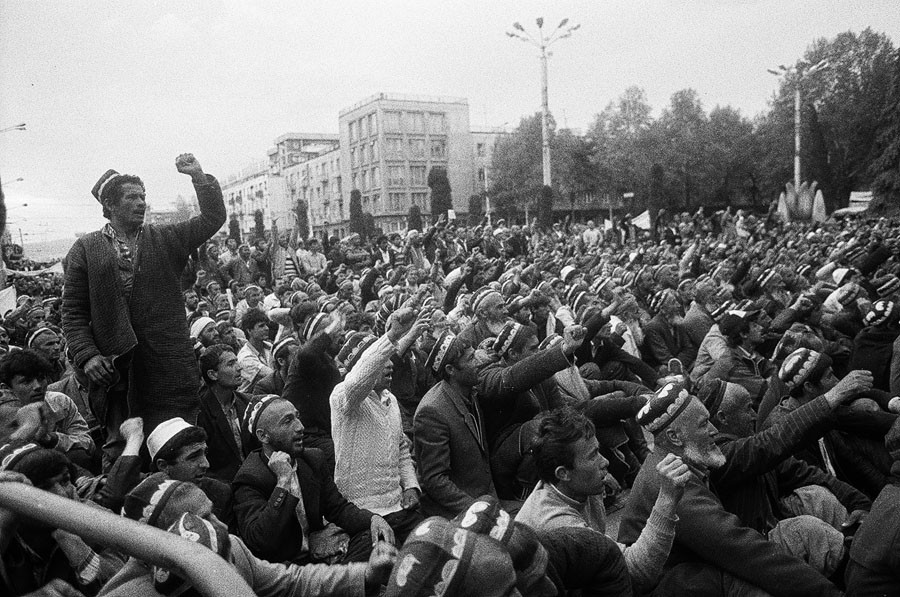Tajikistan unfortunately tends to be treated as an outlier. Located on the edge of the former USSR, it is often cited as the only former Soviet republic to have descended into civil war after 1991. Its religious population is contrasted to its comparatively secular counterparts in the rest of Central Asia, and its ethnic heritage as a lone Persianate outpost surrounded by Turkic neighbors is highlighted. When it comes to explaining the breakdown in social order that occurred at the end of the Soviet period, as well as the subsequent Tajik Civil War (1992–1997), it is these differentiating factors that are often emphasized.
Author

Isaac Scarborough
Isaac Scarborough is a PhD candidate in the Department of International History at the London School of Economics. His research focuses on the period of “perestroika” (1985-1991) in Tajikistan and the impact of late Soviet political and economic reforms on the subsequent outbreak of the Tajik Civil War in 1992.
Clearly, these factors—religious, cultural, and otherwise—have played an important role in recent Tajikistani history. Yet this focus on the ways in which Tajikistan is different has caused another side of the picture to go unseen and uninvestigated, namely Tajikistan’s marked similarities to many of its Soviet neighbors. Rather than emphasize the particularities of the Tajik republic, this history would instead try to embed Tajikistan in the larger history of the Soviet state and economy. This would provide a more complete understanding of the processes that ultimately led to the breakdown of Soviet and post-Soviet order in Tajikistan in 1992. It is, in other words, impossible to comprehend the move into disorder without first grasping what preceded that disorder.
Strikingly, the sharp breakdown of social order in Tajikistan between 1990 and 1992 was preceded by a long and stable period of growth. Research into regional development in the USSR has shown that Tajikistan’s economy was growing at 3% per year in the early and mid-1980s, a rate twice as high as the Soviet average. Industrial growth approached 5% annually, and both salaries and access to consumer goods were increasing year on year. Tajikistan’s cities were growing, but remained calm and safe: murder rates were below 1 per 100,000 residents, and internal KGB records show that there had been no major incidents (disorder, protest, or otherwise) in the republic for decades.
The republican economy did depend in large part on a cotton monoculture, but this represented far less of a “colonial expropriation” or “imperial largesse” than has often been claimed. Instead, the Tajik republic played an integral role in the Soviet “division of labor,” which was meant to avoid the pitfalls and spikes of market capitalism. By specializing in cotton, the Tajik SSR provided the Soviet budget and industry with needed resources and currency. In exchange, the Soviet budget gave the Tajik SSR a steady flow of development rubles, which did not depend on the vagaries of harvest volumes or world commodity prices. Curiously, the exchange was largely balanced, with a slight advantage to the Tajik SSR. If we look at the total value of Tajik cotton to the Soviet budget in the 1980s and compare it to the value of monetary transfers to the republic, we find that in some years, the Tajik SSR sent more value to the budget than it received, but on average it received back a little more than it was providing.
This balance in favor of the Tajik SSR was, in fact, no accident. It was part of the Soviet policy of “equalization” (vyravnivanie), whereby the state committed itself to raising the less-developed Soviet republics to a level equal to Russia and the more developed European parts of the USSR. Though often denigrated as little more than lip service, there is strong economic evidence that the policy continued into the 1980s. Per capita capital investments in Tajikistan in the 1908s, for example, were more than 3 times higher than in Russia, demonstrating that resources were being shifted to the periphery.
“Equalization” (vyravnivanie) is a policy where the state committed itself to raising the less-developed Soviet republics to a level equal to Russia
All this republican growth, however, relied upon the continued existence of the underlying Soviet system: the interlocking planned economy of the USSR. When Mikhail Gorbachev began reforming this system in 1987, it pulled the floor out from under the Tajik economy. The central Soviet government quickly rid itself of many of its functions and responsibilities, emphasizing the idea of “republican economic self-sufficiency” (respublikanskii khozraschet). In practice, local enterprises and new “cooperative” businesses were given the right to purchase raw materials (such as cotton), sell them abroad (for dollars), and pay minimal taxes to the republican budget. The reforms also incentivized employers to let workers go, adding to the already large pools of unemployed Tajik workers. Unemployment reached nearly 30% by 1990, and would continue to grow in 1991 and 1992.

By the time the USSR finally came to an end in December 1991, Tajikistan had declared its independence and was working to establish its own government and political system. It was doing so, however, under conditions of absolute bankruptcy. Its entire economic system had been reliant upon the Soviet Union’s economy; it had only ever existed as part of the larger whole. There were no sources of local revenue other than cotton and aluminum, and these latter enterprises were in the process of being sold off abroad by a new class of businessmen. In the course of two years, a functioning—and improving—social and economic order became a miasma of economic degradation and collapse. Everyone was losing their jobs; those few who had jobs were not being paid; politicians had no money and no solutions to offer. Under such circumstances, it is perhaps little wonder that violence occurred—and the economic side of the slide into violence should remain part of the narrative.
Video by
Erden Zikibay














